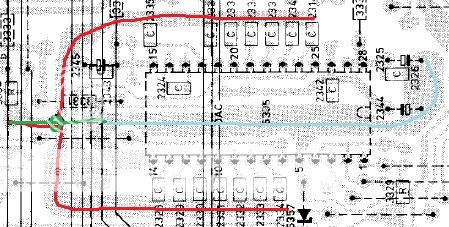a.palfreyman
pfm Member
The bit decoupling caps i had in place (originals plus piggy-backed 0.22MKT and 1uF tants on MSB + adjacent) were removed and replaced with the Panasonic ones above. WOW you were right Mike, what a difference.  I finally have some mid-range detail and the tonal balance is better along with the correction of "false treble" for want of a better description. Don't know if it was the 1uF tants or the combination (with the original ceramic chips) but the difference is quite something to behold. Some time after doing this mod I noticed the player had developed a hum of circa 2mV p-p, 100 Hz on the outputs. Eventually traced it to the 0V return of the -15V supply which is also shared by the bit decoupling caps. A soldered joint had fractured which was modulating this earth plane along with the audio signal. Just shows how important quiet supplies are. Regarding Martin's comments above about using a lower value resistor between the reg and the cap/supply pin. Measured the raw -25Vdc feeding the -15V reg and this has 1.5Vp-p saw-tooth on it and consequently passes 3mVp-p sawtooth through to the output side. I am going to increase the 220uf on the raw DC to 470uF as this should reduce it to about 0.7Vp-p (about the same as the +15V supply) and then place a 100uF on the -15V line just before the resistor that feeds the TDA -15V supply pin.
I finally have some mid-range detail and the tonal balance is better along with the correction of "false treble" for want of a better description. Don't know if it was the 1uF tants or the combination (with the original ceramic chips) but the difference is quite something to behold. Some time after doing this mod I noticed the player had developed a hum of circa 2mV p-p, 100 Hz on the outputs. Eventually traced it to the 0V return of the -15V supply which is also shared by the bit decoupling caps. A soldered joint had fractured which was modulating this earth plane along with the audio signal. Just shows how important quiet supplies are. Regarding Martin's comments above about using a lower value resistor between the reg and the cap/supply pin. Measured the raw -25Vdc feeding the -15V reg and this has 1.5Vp-p saw-tooth on it and consequently passes 3mVp-p sawtooth through to the output side. I am going to increase the 220uf on the raw DC to 470uF as this should reduce it to about 0.7Vp-p (about the same as the +15V supply) and then place a 100uF on the -15V line just before the resistor that feeds the TDA -15V supply pin.
Once this is done and "settled in" i will do some back-to-back listening against my un-modded player.
Thanks again,
AP
Once this is done and "settled in" i will do some back-to-back listening against my un-modded player.
Thanks again,
AP


